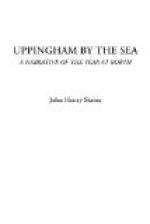Then there was the beach, four miles of it, from the rocks of Borth Head, where the waves could be watched breaking on the seaweed-covered reef, and sending up columns of white spray against the black face of the cliffs, away to the yellow sand dunes near the Dovey’s mouth, and the reaches of wet sands where we noted on summer days “the landscape winking through the heat,” almost with the effect of a mirage. These sands, firm and sound under foot, were a famous walking-ground at all times; but they changed their character very much with the seasons; at one time retreating and laying bare a beach of shingle under the pebble ridge; at another, swinging back to cover them up again. In the former state of the shore a suggestive phenomenon might be observed. At low-water mark there appeared certain dark shapeless lumps, which might be taken for rocks at a distance, but were in fact the roots and stumps of a submerged pine-forest. Remains of the same forest are found in the marsh. Wood can be cut from the buried trunks, looking as fresh in fibre as if the tree still grew. Here is the verification of the legend (or is it, perhaps, the suggestion of it?) which records the fate of the Lost Lowland Hundred. Once on a time (the Cymric bards answer for it), a flourishing tract of country stretched at the foot of the hills which are now washed by the tides of Cardigan Bay. The fishermen of Borth, as they creep past the headlands in their fishing-smacks, have seen deep down in the clear waters, the firmly-cemented stones of a causeway, which must once have traversed the plain, and the line of which may be not indistinctly descried stretching far out to seaward from the mouth of a little combe. It is true that geologists whom we have consulted ridicule the fancy of masonry offering such resistance to the tides, and explain it away as a pebble-ridge built up by the action of currents. And perhaps we might mention in this connection, that one of our party, on the first view, was half persuaded he had seen a sea-serpent. Well, this prosperous country, defended against the sea by embankments, was during the heroic age of Wales laid under water by the opening of the sluices in a drunken frolic. A fragment of it, the marsh between the pebble-ridge of Borth and the hills, would seem to have been recovered; but it enjoys a precarious safety, and even within our experience the sea gave a meaning threat of claiming his own again. But that is a story which must be told in its own place.
Such then were the geographical details of the spot in which we had settled, and they made up a landscape, which, if it can be more than rivalled in other parts of the Principality, has yet a characteristic and impressive beauty. The following extract may serve, for lack of a better rendering, to describe how the scene looked to the eyes of someone who watched it on a June afternoon from the grassy slopes of Borth Head:




